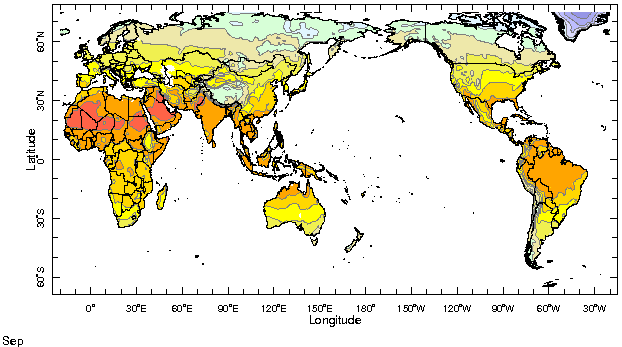|
IRI Climate Digest
October 2002
September Global Climate Summary
Climatological Background
During September, the Northern Hemisphere monsoon systems in West Africa, South Asia, and southwestern North America begin their retreat southward following the maximum solar heating which approaches the equator at the time of the equinox (September 21). Spring has begun in the Southern Hemisphere, with mid-latitude storm tracks losing strength.
Monthly Mean Temperature (1961-1990), data from the Climate Research
Unit, University of East Anglia


Monthly Mean Precipitation (1961-1990), data from the Climate Research
Unit, University of East Anglia


Temperatures
Highlights
Warmer than average conditions developed in the regions of eastern North America, northern Europe and western Asia, while cooler than average temperatures were experienced across the northern tier of Russia.
Temperature Difference from the 1961-1990 mean, with data
from NCEP Climate Prediction Center, CAMS.


Precipitation
Highlights
Boreal Summer Monsoon Summary Total rainfall in the monsoon regions of the northern hemisphere, including South Asia and West Africa, was below normal during the summer monsoon season. As noted in the India Meteorological Department's Southwest Monsoon 2002 End-of-Season Report, the 2002 summer monsoon ended with the first all-India drought since 1987, largely due to the all-time record low rainfall in July (49% of normal for India as a whole). In West Africa, precipitation was below normal in the Sahel and the Guinea Coast region throughout much of the season. In the Sahel, countries in the far west, especially Mauritania, Senegal, and Gambia, accumulated the greatest rainfall deficits, with some locations receiving only 25% to 50% of their normal rainfall by the end of September.
Southeast Asia Tropical storm Mekkhala brought heavy rainfall to the Philippines, Vietnam, and southern China in late September.
Mexico and Central America Extremely dry conditions continued in Mexico and much of Central America again in September, making this the second very dry summer in a row in Central America.
Indonesia and Australia Dry conditions continued for another month in Indonesia, and there was no sign of a break in the Australian drought.
Caribbean and the United States Hurricanes Isidore and Lily brought heavy rainfall to Jamaica and produced a swath of above-normal rainfall through the Southeast and Midwest of the United States.
Europe Areas in the eastern Mediterranean and Eastern Europe experienced wetter-than-normal conditions while there was below-normal precipitation in parts of Scandinavia and Western Europe.
China Dry conditions continued in much of eastern China and northward into Manchuria.
Precipitation Difference from 1961-1990 mean, with data
from NCEP Climate Prediction Center, CAMS-OPI.


Oceanic Conditions
Tropical Pacific: The current El Niņo continued to mature during September, but is not expected to exceed moderate strength. Its broad region of anomalously warm water extended its reach into the eastern Pacific, while sea surface temperatures (SSTs) in the central Pacific are now as high as 2.5°C above normal. Please see the latest IRI ENSO Update for a detailed summary and outlook.
Tropical Atlantic: Near normal conditions were experienced across the tropical Atlantic as the higher than average SSTs off the coast of West Africa continued to dissipate.
Indian Ocean: Surface temperatures continued to be higher than average as the strongest anomalies became more dominant in the western and central regions of the ocean.
Mid latitudes: Though weakened slightly, the cold anomalies in southeastern Atlantic and northwestern Pacific continued, as did the warm anomalies in the northwestern Atlantic.
Monthly Sea Surface Temperature Difference from the 1950-1979 mean,
with data from the Environmental Modeling Center, NCEP/NOAA.


Contents |
Special |
Impacts |
Climate |
Forecast
|

